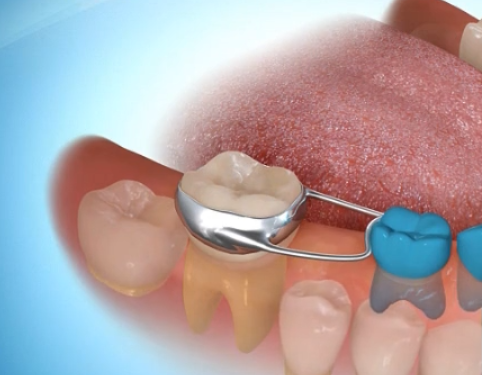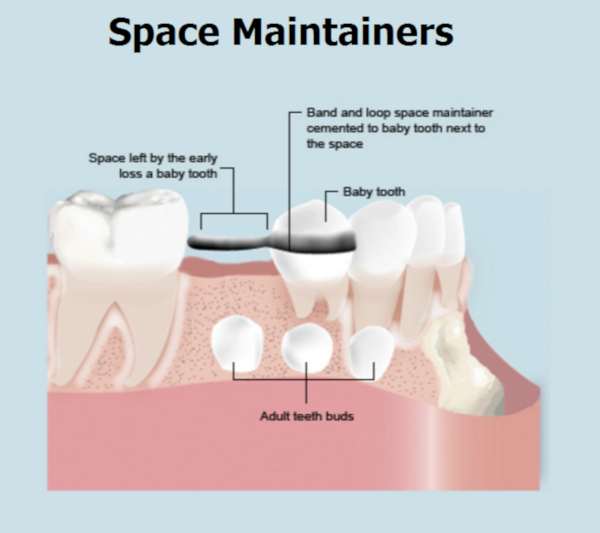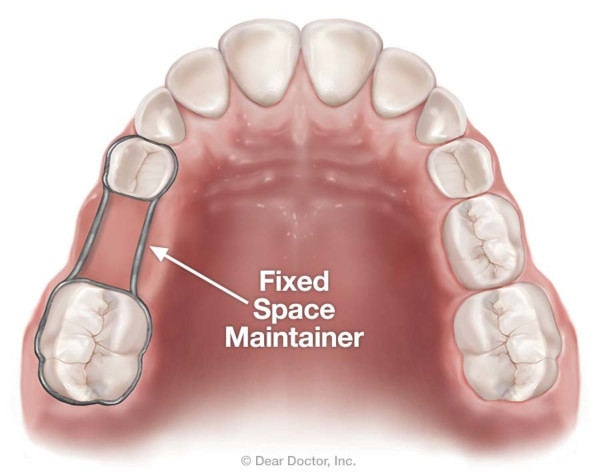Space Maintainers
Space maintainers, eh? Want to know more? Then you’ve come to the right place…..
No, they’re not from outer space, despite their name. And no, they will not pick your brains out if you test them. And certainly no, they are not designed to maintain your car, house or fridge space, but what can they do?
They work with your oral space, to put it bluntly. Actually, they help your child’s. They are a product designed for children to use ideally after they’ve lost any number of teeth early or have simply had primary teeth (otherwise more commonly called “baby teeth”) pulled out of their socket….due to dental decay or something similar. And believe it or not --- the U.S. expert reports just released from multiple sources citing the ADA (American Dental Association) have just shown that, now more than previously, more children need to get space maintainers. So parents, carve out some room in your budget, because it’s time to get your children checked out for this!
Some Facts About Space Maintainers

Licensed dentists and orthodontists are able to make this special appliance - product in a custom fashion so that it works around the child’s teeth and adjusts its own parameters as needed. Metal or acrylic material usually make up the space maintainer. And one always has the option of implanting the appliance permanently in the mouth so that it stays fixed for the rest of the child’s life or simply going with a more removable, temporary solution.
The purpose of this space maintainer, furthermore, is to permit the child’s tooth to erupt and fall into its rightful place through keeping the space open. Hence, the name makes some more sense now, in retrospect. But to further explore, we would find that baby teeth are no less than crucially important to the development of all other teeth in the mouth as well as the muscles and jaw bones, respectively. After all, the permanent and new forming teeth have to be guided into their proper position after the baby ones have finished falling out.

If the space mentioned isn’t properly maintained, then, orthodontic intervention will be needed as it is now more likely that those teeth have already begun to shift straight into the open space. The sooner the prevention and intervention, the better. Time is of the essence here.
MORE About Space Maintainers
Here are some more facts to note and some other sound advice to consider.
Get a consultation with an expert, first, to see if your child will actually need a space maintainer as their solution. Sit down and count the cost. But more importantly than anything, discuss with your child and the dentist or orthodontist which option might be the better of the two, considering all the factors that play into the child’s present situation:

A fixed appliance space maintainer - This one’s made out of acrylic, 9 times out of 10. Many dentists even use an artificial, pre - made tooth in order to fill the void where the other tooth has been, keeping the space open prior to that (so that the un - erupted tooth may properly come out in its time).
A removable appliance space maintainer - Fixed space maintainers tend to come in four types, and the first is the unilateral kind, followed then by the lingual, which precedes the distal shoe, and last but not least, concluding with the crown and loop. The unilateral type has everything to do with wrapping itself around the tooth’s outside areas and then connecting to the metal loop holding the entire space intact. As for the lingual maintainer, this one’s bilateral in nature and can cement onto your molar teeth.
The distal shoe does everything it can to prevent the first permanent molars erupting from moving forward in a function that would otherwise hinder or inhibit any secondary molars from being able to rise and grow properly in their place. Also, the crown and loop is good for when you need to put a stainless steel crown on the tooth that’s also acting as your space maintainer’s abutment, respectively.
The importance of your child’s baby teeth
Here’s the bottom line on the matter: If your child should lose any of his or her baby teeth in a pre - mature manner , then the other teeth around can shift themselves into the empty space where the baby teeth resided and thus not leave sufficient room for the erupting teeth, which will be permanent, to come in correctly. What follows, then, is crooked or crowding teeth --- now do you see how that can be a problem? And we can’t mention it enough!
Plus, your child is in the formative years of his or her life and needs to start forming a good, healthy set of teeth and gums. This will affect other areas of life, such as health issues affected by the mouth, bone and calcium arraignment, even self - esteem as a result of having straight or crooked teeth, and way down the line (believe it or not), potential job and relationship security and satisfaction --- true fact. Think about the consequences that may come with neglecting the need your child has for a space maintainer. It’s no laughing matter.
Also, malocclusion, which many dentists more simply refer to as a “bad bite”, is another problem that can be prevented through a space maintainer. So get your child checked out. Do it early and often, prepared for when that last “baby tooth” may fall off, once and for all.
Final thoughts
We don’t say all of this to just scare you. Instead, we simply want you to be aware and prepare (hey, that rhymed). When your child loses a baby tooth, in any case, you need to take him or her to see an orthodontist or dentist right away so that a proper set of X - rays and other assessments may be taken. Never take this lightly as baby teeth lost leads to permanent teeth about to erupt, and these teeth will stay with you for life…..
Learn more:
